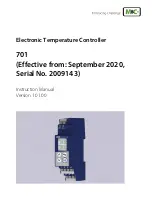
Doc.Ref. No. m83B/QG/101 Issue No.:00
Page
2
of
2
Construction, Installation & Wiring
Specification
MATERIAL
Aluminum extrusion
CONSTRUCTION
Panel Mount Top and
Bottom mounting clamps (1
each)
CASE COLOR
Clear Anodized
WEIGHT
1.25 KG
ENCLOSURE
DIMENSION
72mm (W) X 144mm (H) X
165mm (D)
PANEL CUTOUT
68.5mm (W) x 137mm (H)
MOUNTING DETAILS
TERMINAL CONNECTION
DO – RL Relay Terminals: 16
Pre-Feb. Cable
Power Supply: Live (L/+), Neutral(N/-) and Earth
(
)
Pre-Feb. Cable
AI-1,2 and 3 Analog Input: 72
or
AI-1 Analog
Input: 8 and
DI-1 Digital Input: 16
Pre-Feb. Cable
DO – OC Digital Contact Output: 25
or
AO – Analog
Contact Output: 16(Optional)
Pre-Feb. Cable
RS-485 Communication: 4
Wire Size: 26- 16AWG
Screw Size: M2.0 Steel Ni Plated
Ethernet Communication: 1
RJ-45 Connector
FRONT PANEL DESCRIPTION
Symbol
Operation
It allows Mode Selection during Run mode,
while it allows saving value of a parameter
inside a mode. When inside any mode, it
allows to enter in sub-mode.
It is used to come out from mode/Sub-
mode. It is also used to escape from edit
mode without saving the respective
parameter.
It is used in increment of value in run mode
and other modes
It is used in decrementing value when run
mode and other modes. It is also used for
shifting a digit while editing of numeric
value.
It allows user to toggle between Auto
Channel Display mode – Manual Channel
Display Mode.
Acknowledge the Alarm During RUN Mode.
Enter into Set Alarm1 and Alarm2 mode
during RUN Mode
When pressed in run mode it will allow the
user to enter into Control Set point Mode
Control Output Operation
Control O/P is the simplest form of temperature control.
The output from the device is either on or off, with no
middle state. For heating control, the o/p is on when the
temperature is below the set point, and off above set point.
Since the temp. crosses the set point to change the o/p
stage, the process temp. will be cycling continually, going
from above set point to below, and back above. In cases
where this cycling occurs rapidly, and to prevent contactors
and valves from getting damaged, on-off differential, or
Hysteresis is added to the control operations.
This Hysteresis assures, if temp. goes below set point by a
certain amount before then only o/p will turn off or on
again. On-Off Hysteresis prevents the o/p from chattering
or making fast, continual switches if the cycling above and
below the set point occurs very rapidly. Once Process value
reaches down to set point-Hysteresis value relay will be
energized and it will be on until process value goes up
towards Set point.
BASIC DO (DIGITAL OUTPUT) FUNCTION
WATCHDOG TIMER / OUTPUT OPERATION
The WDT, when enabled, operates from the internal Low-
Power RC (LPRC) Oscillator clk source. The WDT can be
used to detect system software malfunctions by resetting
the device if the WDT is not cleared periodically in
software. If malfunctioning of device persist even after
watchdog reset device will go into shutdown mode followed
by error messages on display as per Error! Reference
source not found..
Device Fault can be monitored by a failsafe relay o/p which
is mapped for watchdog o/p.
When WDT is disable device
will continue to work with fault. The Fault LED will be on in
this condition.
Error Messages
Fault
Error 1
CPU card EEPROM failure
Error 2
SC 1 card ADC failure
Error 3
SC 1 card EEPROM failure
Error 4
SC 2 card ADC failure
Error 5
SC 2 card EEPROM failure
Error 6
SC 3 card ADC failure
Error 7
SC 3 card EEPROM failure
Error 8
CPU card Controller Hang –
failure
Error 9
Communication between CPU and
Display card Failure
ALARM OUTPUT
Every single channel can have maximum 3 set points. 2 for
Alarm outputs(1 for Alarm 1 Set Point and 1 for Alarm 2
Set Point) and 1 for Control Set Point, totaling 48 alarm
outputs and 24 control outputs for 24 number of channels.
Control Outputs are Optional.
8 Relays and/or 24 Open Collectors can be used as DO.
All Digital Outputs are Optional.
Following tables shows Alarm Output , control output
and digital output operation.
For operation manual please visit www.masibus.com
Specifications are subject to change without notice due to
continuous improvements.
Masibus Automation And Instrumentation Pvt. Ltd.
B-30, GIDC Electronics Estate, Sector-25, Gandhinagar-
382044, Gujarat, India.
Tel:+91 79 23287275-79 Fax: +91 79 23287281
Web:www.masibus.com Email:[email protected]




















